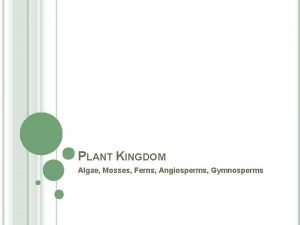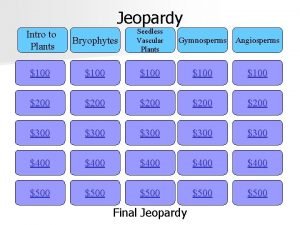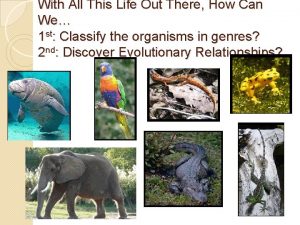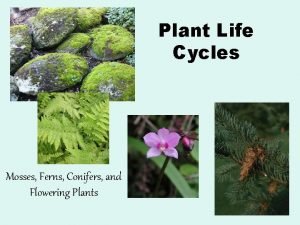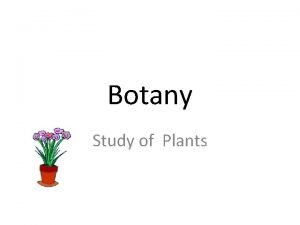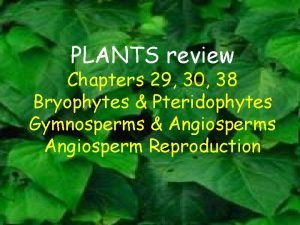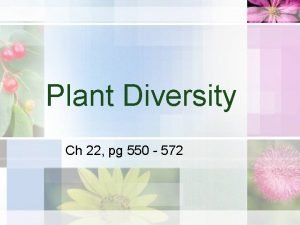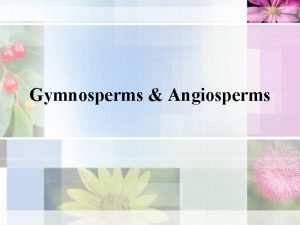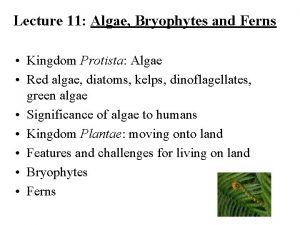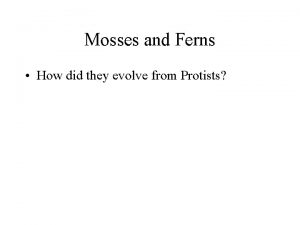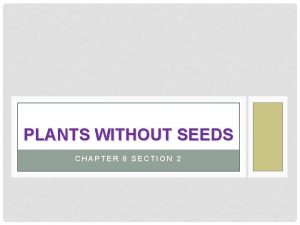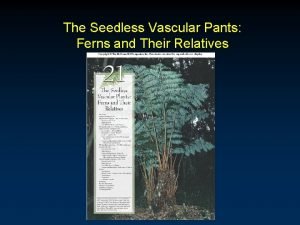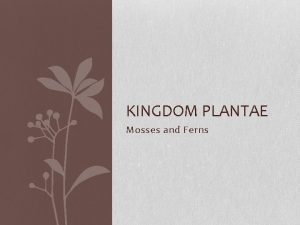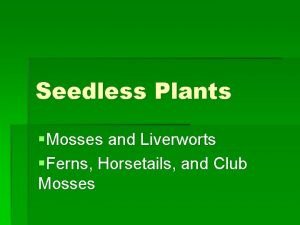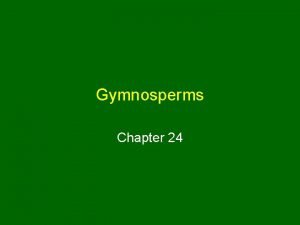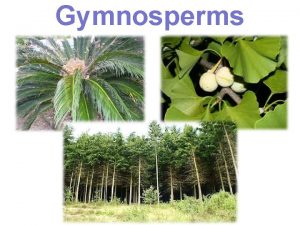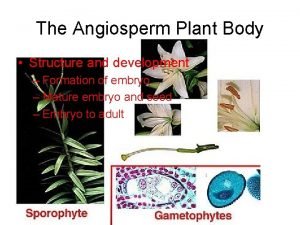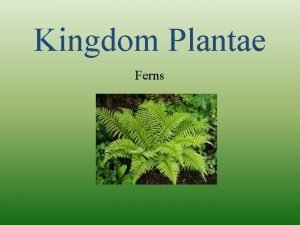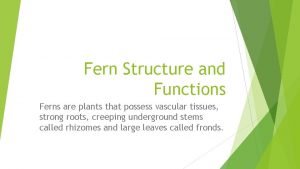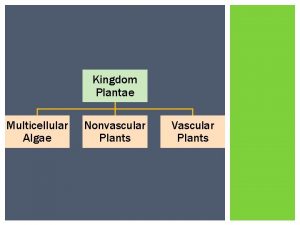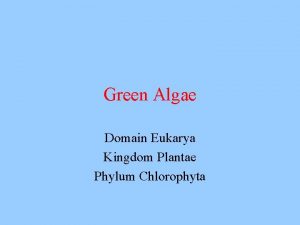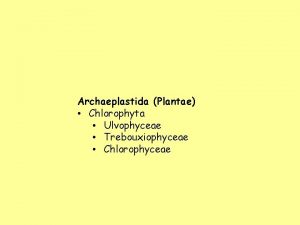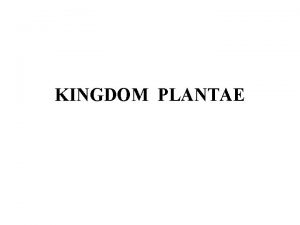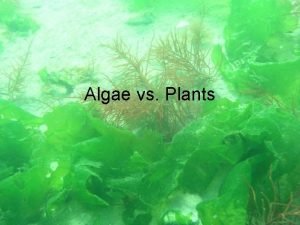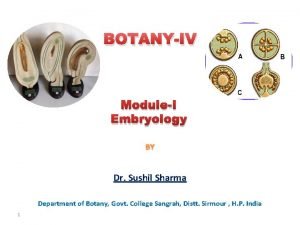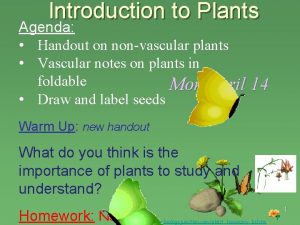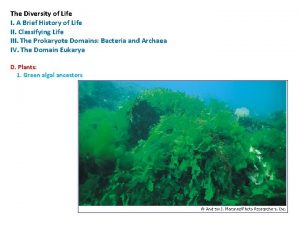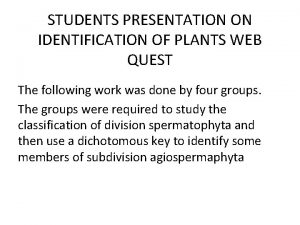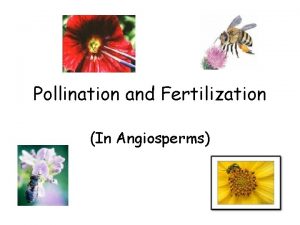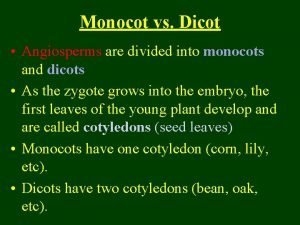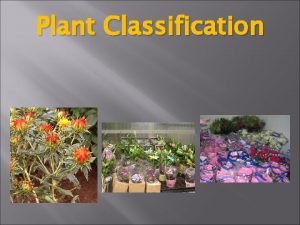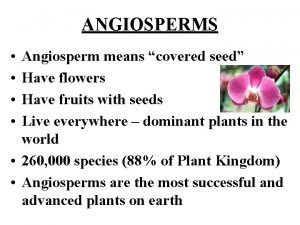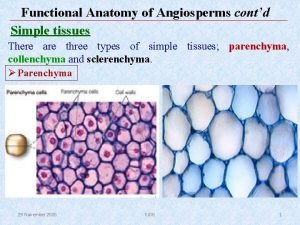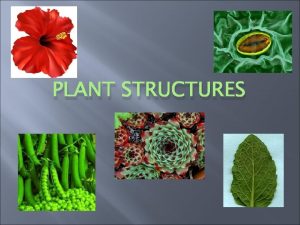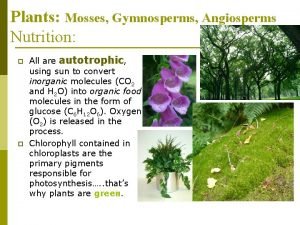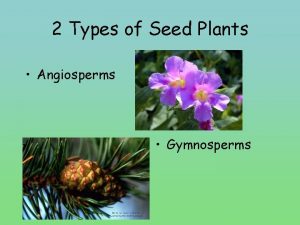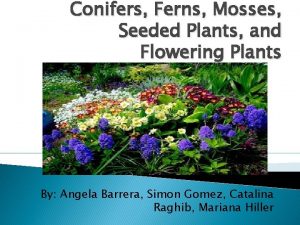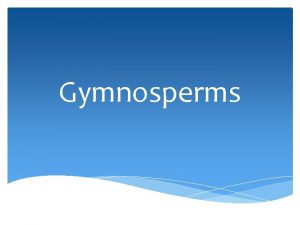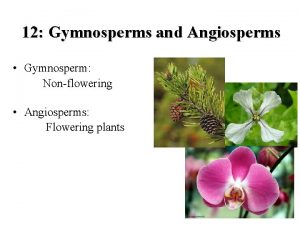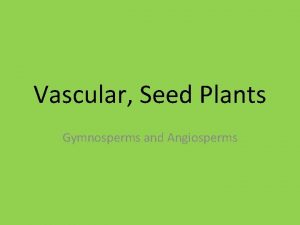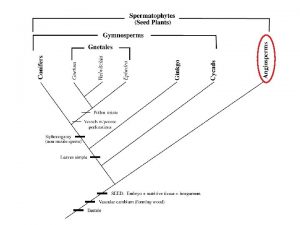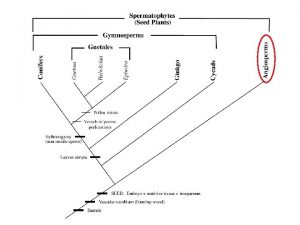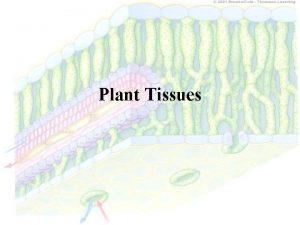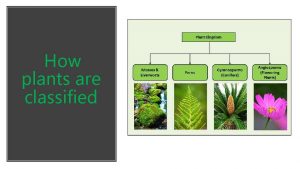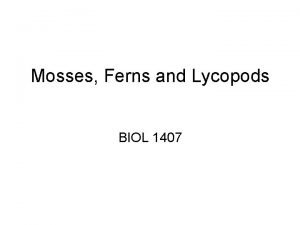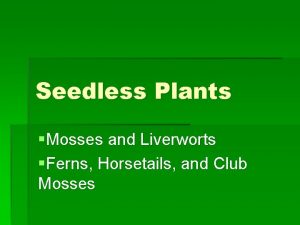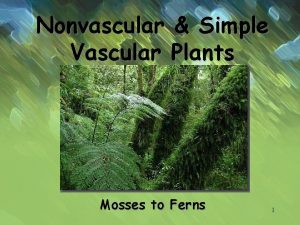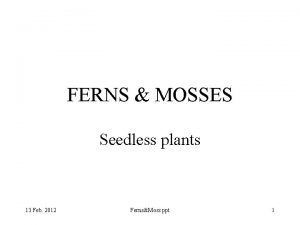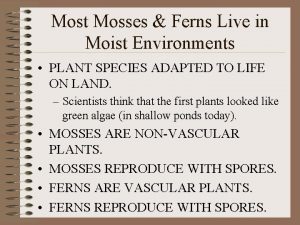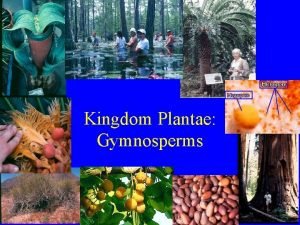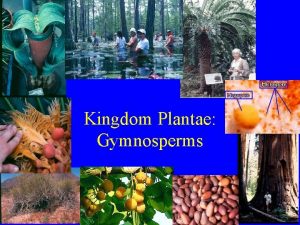PLANT KINGDOM Algae Mosses Ferns Angiosperms Gymnosperms PLANTS











































- Slides: 43

PLANT KINGDOM Algae, Mosses, Ferns, Angiosperms, Gymnosperms

PLANTS – ALGAE – WATER PLANTS

DESCRIPTION Photosynthetic organisms Live in fresh water and oceans

MUST LIVE IN OR NEAR A SOURCE OF WATER Lack of internal system of tubes to move material from one part to another � No roots or stems like land plants Water they live in: � Exchange CO 2, O 2 and nutrients directly with water � Carries away wastes

TYPES OF ALGAE Most are multicellular � Giant kelp can grow 60 m Unicellular are microscopic (can also be classified as protists)

STRUCTURES Cells have cell walls Never have roots, stems or leaves like land plants

ADAPTATIONS OF ALGAE TO LIFE UNDER WATER Because they: This means Algae: Don’t need protection from Are thin (only 2 cells thick) drying out Exchange materials Have no vascular tissue directly with surrounding water Are supported by water Reproduce in water Don’t need stems to keep from falling over Make gametes that swim

CHLOROPHYLL AND ACCESSORY PIGMENTS Challenges of underwater life Water absorbs much of the energy of sunlight 2. Algae groups have evolved different forms of chlorophyll that absorb different wavelengths of light 3. Some also evolved other light absorbing compounds called accessory pigments 1. 2. They can live in deeper water Different reflected wavelengths give algae a wide range of colors

TYPES OF ALGAE – GREEN ALGAE Chlorophyta Found mostly on moist land in fresh water

TYPES OF ALGAE – BROWN ALGAE Phaeophyta Marine habitat: especially cool, shallow waters in temperate or arctic oceans,

Most “sea weeds” are species of brown algae � Giant kelp � Fucus (Rockweed) Functions of: � Holdfast: attaches plant to ocean bottom � Bladders: Keep plant upright and in water

TYPES OF ALGAE – RED ALGAE Rhodophyta Marine Habitats: from arctic to tropics, from surface to 170 m deep due to accessory pigments Example: Porphyra (dried; its called nori and is used to make sushi)

ALGAE LIFECYCLE Include diploid (2 n) and haploid (n) generations Switching back and forth is known as ALTERNATIONS OF GENERATIONS � This is a characteristic of the plant kingdom Algae also shifts between sexual (gametes) and asexual (zoospores) for reproduction

REPRODUCTION OF ULVA (SEA LETTUCE – GREEN ALGAE ) Diploid (2 n) and haploid (n) stages are multicellular Diploid plant is called the sporophyte Haploid plant is called the gametophyte When two gametes fuse, the diploid sporophyte forms

The sporophyte undergoes meiosis and releases haploid zoospores (+ and -) which in turn form the gametophytes The gametophytes release gametes (+ and -) which fuse to form sporophytes


PLANTS INVADE LAND

The Demands What land plants must do Provide cells with a constant water supply a) Find water b) Deliver it to all cells c) Protect against water loss by evaporation Expose food-making parts to sunlight Need rigid support to hold up and expose leaves Different tasks performed in Need a transport system: distant plant parts: a) Water/nutrients upward a) Roots take up water & nutrients b) Sugars made by b) Leaves make food photosynthesis downward For reproduction, gametes must find each other Need a mechanism to deliver sperm that doesn’t involve having them swim

MOSSES – BRYOPHYTES nonvascular plants

THE MOSSES, LIVERWORTS AND HORNWORTS Need water for reproduction to occur Thrive only in wet areas swamps, marches, near streams, in rainforests All less than a few cm tall

Each plant has: �A thin upright shoot like a stem with tiny leaves called the gametophyte � From the base of the shoot grow rhizoids that anchor the plant � Shoots may be topped with a brown flag-like structure called a sporophyte

Capsule Sporophyte Seta Stem and Leaves Gametophyte Rhizoids

PHYSICAL CHARACTERISTICS Water Conduction 1. 2. 3. 4. 5. 6. Lack tubes Water passes between cells by osmosis and surface tension These methods work over short distances Lack a protective surface covering to prevent evaporation Leaves one cell thick, dry out quickly Lack true roots Rhizoids anchor, but don’t absorb and transport water/minerals

REPRODUCTION Sperm must swim to the egg using flagella to propel themselves Moss environment must be wet for at least part of the year

THE MOSS LIFE CYCLE –ALTERNATION OF GENERATION

LIFE CYCLE STAGES At the tips of the gametophytes � Antheridium: makes sperm � Archegonium: makes eggs

Fertilization � Sperm (1 n) swims to archegonium � Plants must be covered with rainwater or dew � Games fusion produce a zygote (diploid: 2 n)

Growth of 2 n generation � Zygote grows into sporophyte � Its water and nutrients are supplied by female gametophyte � Sporophytes cannot live independently � Capsule at end of stalk makes haploid (1 n) spores by meiosis

Spore Release � When ripe, capsule opens, shakes out spores � Spores carried off by wind and water

Growth of 1 n generation � Spores that land in moist places germinate into protonema mass of tangled green filaments (looks like algae) � This grows rhizoids into soil and shoots into the air that develop into moss gametophytes � Cycle repeats!

Summary: � Gametophyte (1 n) is the dominant, obvious stage � Fertilization requires standing water � Sporophyte is dependent upon gametophyte

FERNS – TRACHEOPHYTA Vascular Plants

“True” land plants because they have evolved ways for freeing themselves from dependence of wet environments

Vascular tissue (2 types) � Xylem: moves water from roots to rest of plant � Phloem: transports nutrients & photosynthesis

Tracheid cells in xylem have thick, strong walls that help plants stand up against gravity True roots have transport tissue in a central vascular cylinder True leaves have: � Veins: bundles of vascular tissue � Cuticle: waxy covering that prevents water loss

CHARACTERISTICS Have true vascular tissues True roots Underground stems called rhizomes Large leaves called fronds Size: up to 1 m tall Found in wet or seasonally wet places

ALTERNATIONS OF GENERATIONS IN FERNS

Spore production/release � Adult sporophytes produce haploid (1 n) spores on underside of fronds � Formed in tiny containers called sporangia � Sporangia cluster together in groups called sori � When ripe, spores released; carried by wind/water

Growth � Spores develop into haploid (1 n) gametophytes � Grow into small, heartshaped prothallium � Antheridia and archegonia develop on underside of prothallium

FERTILIZATION Antheridia release sperm Sperm must swim through a film of water to an archegonium Each archegonium contains one egg Fusion of gametes produces a diploid (2 n) sporophyte

GROWTH New sporophyte puts out fronds, rhizomes Gametophyte withers away

SUMMARY 1. Dominant, obvious stage is the sporophyte 2. Sporophyte is a welldeveloped land plant with true vascular tissue 3. Gametophyte can only grow in moist areas 4. Sex still requires water

SEED PLANTS –ANGIOSPERMS AND GYMNOSPERMS
 Algae mosses and ferns
Algae mosses and ferns The most widespread bryophytes are _____.
The most widespread bryophytes are _____. Cladogram of five indoor plants
Cladogram of five indoor plants Ferns conifers and angiosperms
Ferns conifers and angiosperms Contrast gymnosperms and angiosperms
Contrast gymnosperms and angiosperms Bryophytes pteridophytes gymnosperms and angiosperms
Bryophytes pteridophytes gymnosperms and angiosperms Plants
Plants Gymnosperms do not produce fruit
Gymnosperms do not produce fruit Ferns
Ferns Mosses and ferns
Mosses and ferns Vascular and nonvascular plants
Vascular and nonvascular plants Seedless pants
Seedless pants Plantae kingdom characteristics
Plantae kingdom characteristics Ferns horsetails and club mosses
Ferns horsetails and club mosses Importance of gymnosperms
Importance of gymnosperms Conifer life cycle diagram
Conifer life cycle diagram Old kingdom middle kingdom new kingdom
Old kingdom middle kingdom new kingdom Old kingdom middle kingdom new kingdom
Old kingdom middle kingdom new kingdom Nnn ruled
Nnn ruled Youtube
Youtube Plant body of angiosperms
Plant body of angiosperms Ferns
Ferns Fern parts and functions
Fern parts and functions Blue green algae kingdom
Blue green algae kingdom Marine plantae
Marine plantae Linnaeus
Linnaeus Green algae phylum
Green algae phylum Ulvophyceae
Ulvophyceae Eukaryotic cell
Eukaryotic cell Různobrvky
Různobrvky Physiology of algae
Physiology of algae Algae vs plants
Algae vs plants Protist vs fungi
Protist vs fungi Gymnosperms phylum
Gymnosperms phylum Albuminous cells of gymnosperms are equivalent to
Albuminous cells of gymnosperms are equivalent to Terrestrial plant
Terrestrial plant Gymnosperms characteristics
Gymnosperms characteristics Classification of gymnosperms ppt
Classification of gymnosperms ppt Double fertilization in angiosperms
Double fertilization in angiosperms Dicot shoot
Dicot shoot Tagetes lower classifications
Tagetes lower classifications Parallel venation diagram
Parallel venation diagram Collenchyma
Collenchyma Dicot seed germination diagram
Dicot seed germination diagram
